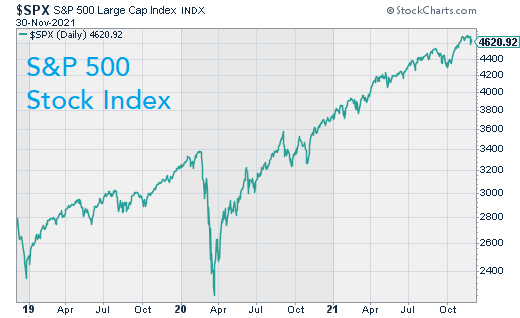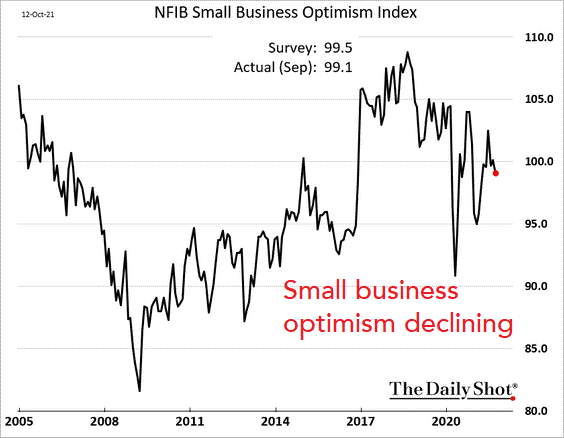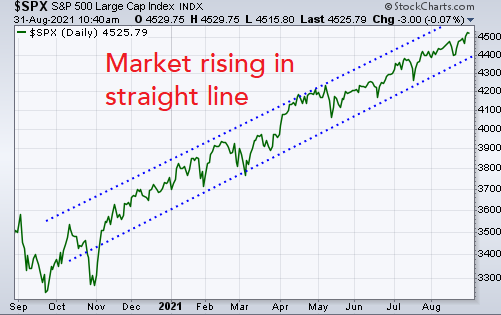Hello all – we hope you had a nice November. Hard to believe we are already in December.
Stocks started the month moving higher, only to stall and move quickly lower at the end of the month. For all of November, the Dow fell 3.7%, the S&P 500 lost 0.7%, and the Nasdaq, which has a higher concentration of technology companies, was up 0.3%.
Stocks started the month moving higher, only to stall and move quickly lower at the end of the month. For all of November, the Dow fell 3.7%, the S&P 500 lost 0.7%, and the Nasdaq, which has a higher concentration of technology companies, was up 0.3%.
_____
There wasn’t a lot going on this month to move markets. Corporate earnings for the third quarter have wrapped up and they were pretty decent. Economic data, too, has been fairly decent. But neither were enough to move markets much this month.
The Fed did announce that they would begin pulling back on one of their stimulus programs, where they print money to buy bonds in order to keep borrowing costs low. This stimulus has been helpful in keeping the markets elevated, so its gradual reduction is removing part of the tailwind for stocks.
A new factor re-emerging at the end of the month was the Coronavirus, as you are probably well aware. The new strain doesn’t seem as “scary” as the others, but that hasn’t kept the markets from selling off. The news actually caused the worst day of the year for stocks.
The Fed did announce that they would begin pulling back on one of their stimulus programs, where they print money to buy bonds in order to keep borrowing costs low. This stimulus has been helpful in keeping the markets elevated, so its gradual reduction is removing part of the tailwind for stocks.
A new factor re-emerging at the end of the month was the Coronavirus, as you are probably well aware. The new strain doesn’t seem as “scary” as the others, but that hasn’t kept the markets from selling off. The news actually caused the worst day of the year for stocks.
_____
The new Coronavirus has many investors believing the Fed will be less likely to pull back further on their stimulus.
The Fed has also been in the hot seat over the high level of inflation. They’ve called it “transitory” for many months, but inflation keeps rising.
Data out this month showed inflation at the consumer level (what we pay in the stores) is up 6.2% over the past year, the highest level in 30 years.
Data out this month showed inflation at the consumer level (what we pay in the stores) is up 6.2% over the past year, the highest level in 30 years.
Of course, the way they calculate inflation has changed over the years (to conveniently make inflation look lower). If we measured inflation the way they calculated it 30 years ago, inflation would be closer to 10% - much higher than the way it is reported now.
Another way of looking at inflation is at the producer level, or what businesses pay before passing it on to shoppers.
Inflation at the producer level (or PPI) currently stands at its highest level ever.
Inflation at the producer level (or PPI) currently stands at its highest level ever.
As for other economic data, the trend still looks pretty good.
More people are finding work and less are applying for unemployment.
More people are finding work and less are applying for unemployment.
The manufacturing and service sectors of our economy both remain strong.
Retail sales are higher - but that is only measuring that people spent more at stores. Are they buying more things, or are they just paying more for the same or maybe even fewer things? It’s hard to tell from the data.
Durable goods - which are items with a longer life, like a phone or dishwasher - were slightly lower.
Sentiment has been falling, however. The general public is less optimistic:
Small businesses owners are less optimistic, too:
_____
Where does the market go from here?
Stocks may have a few tailwinds going for it here. We are now entering December, which tends to be one of the best months for stocks.
Stocks may have a few tailwinds going for it here. We are now entering December, which tends to be one of the best months for stocks.
Additionally, stocks have tended to bounce back after sharp rises in volatility.
While these are positives, there’s still a lot of unknowns. We have the Coronavirus, the Fed pulling back on its stimulus, and another debt ceiling fight approaching.
This December could be a volatile one.
This December could be a volatile one.
This commentary is for informational purposes and is not investment advice, an indicator of future performance, a solicitation, an offer to buy or sell, or a recommendation for any security. It should not be used as a primary basis for making investment decisions. Consider your own financial circumstances and goals carefully before investing. Past performance cannot guarantee results.

































































